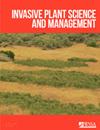空中喷洒三氯吡虫啉、麦草畏和吡氯虫啉后环境中的持久性
IF 1.2
4区 生物学
Q3 PLANT SCIENCES
引用次数: 0
摘要
在新西兰,空中施用三氯吡、麦草畏、苦草胺和氨基吡喃草胺的除草剂混合物用于控制外来针叶树的密集侵扰,尤其是洛奇波尔松(Pinus contorta Douglas)。用于控制这些树木杂草的除草剂在森林地面、土壤和水中的持久性可能会产生偏离目标的影响。研究了其中三种除草剂在新西兰三个地点(KF、MD、GE)进行空中施用后,在铸针、森林地面(枯枝落叶层、发酵腐殖层:LFH)和土壤中的持久性。在喷洒后的几天/几个月内,在两个地点(KF,MD)从当地溪流中收集水。在铸针、LFH和矿物土壤的所有地点检测到的活性成分通常反映了它们的施用率,总量包括81%的三氯吡、14%的麦草畏和5%的苦草胺。大多数活性成分在LFH(59%)中检测到,LFH是覆盖在土壤上的一层富含木质素的枯针。所有三种除草剂在该层、所有地点持续使用长达2年(研究终止时)。在一年内下降到低于检测水平(0.2 mg kg-1)的矿物土壤中,仅检测到三氯吡。在KF喷洒当天和一个月后的一次降雨中,在溪流中检测到了所有三种除草剂。然而,水量没有超过新西兰的环境和饮用水标准,这是由于该场地使用了30米的无喷雾缓冲区。在MD,喷洒后四个月内可以在水中检测到除草剂,喷洒后一个月,除草剂的含量一度超过新西兰饮用水标准。MD现场未使用喷雾缓冲区。本文章由计算机程序翻译,如有差异,请以英文原文为准。
Persistence of triclopyr, dicamba and picloram in the environment following aerial spraying for control of dense pine invasion
Aerial application of a herbicide mixture of triclopyr, dicamba, picloram and aminopyralid is used to control dense infestations of exotic conifers, notably lodgepole pine (Pinus contorta Douglas), in New Zealand (NZ). The rates of herbicide applied to control these tree-weeds has the potential for off-target impacts through persistence in the forest floor, soil and water. Persistence of three of these herbicides was investigated in cast needles, forest floor (litter, fermented humic layer: LFH) and soil following their operational aerial application (triclopyr:18 kg a.i. ha-1; dicamba: 5 kg a.i. ha-1; picloram: 2 kg a.i. ha-1) at three sites across NZ (KF, MD, GE) with dense invasions of P. contorta. Water was collected from a local stream at two sites (KF, MD) in the days/months after spraying. Active ingredients detected across all sites in cast needles, LFH and mineral soil generally reflected their application rate, with total amounts comprising 81% triclopyr, 14% dicamba and 5% picloram. Most of the active ingredients were detected in the LFH (59%), a heavy lignin-rich layer of dead needles overlaying the soil. All three herbicides persisted in this layer, at all sites, for up to 2 years (at study termination). Only triclopyr was detected in mineral soil where it declined to below detection levels (0.2 mg kg-1) within one year. All three herbicides were detected in stream water on the day of spray application at KF, and during a rainfall event one month later. However, amounts did not exceed NZ environmental and drinking water standards, an outcome attributed to a 30 m no-spray buffer zone used at this site. At MD, herbicides were detectable in water up to four months after spraying, with amounts exceeding NZ drinking water standards on one occasion, one month after spray application. No spray buffer zones were used at the MD site.
求助全文
通过发布文献求助,成功后即可免费获取论文全文。
去求助
来源期刊

Invasive Plant Science and Management
PLANT SCIENCES-
CiteScore
2.20
自引率
9.10%
发文量
24
审稿时长
6-12 weeks
期刊介绍:
Invasive Plant Science and Management (IPSM) is an online peer-reviewed journal focusing on fundamental and applied research on invasive plant biology, ecology, management, and restoration of invaded non-crop areas, and on other aspects relevant to invasive species, including educational activities and policy issues. Topics include the biology and ecology of invasive plants in rangeland, prairie, pasture, wildland, forestry, riparian, wetland, aquatic, recreational, rights-of-ways, and other non-crop (parks, preserves, natural areas) settings; genetics of invasive plants; social, ecological, and economic impacts of invasive plants and their management; design, efficacy, and integration of control tools; land restoration and rehabilitation; effects of management on soil, air, water, and wildlife; education, extension, and outreach methods and resources; technology and product reports; mapping and remote sensing, inventory and monitoring; technology transfer tools; case study reports; and regulatory issues.
 求助内容:
求助内容: 应助结果提醒方式:
应助结果提醒方式:


